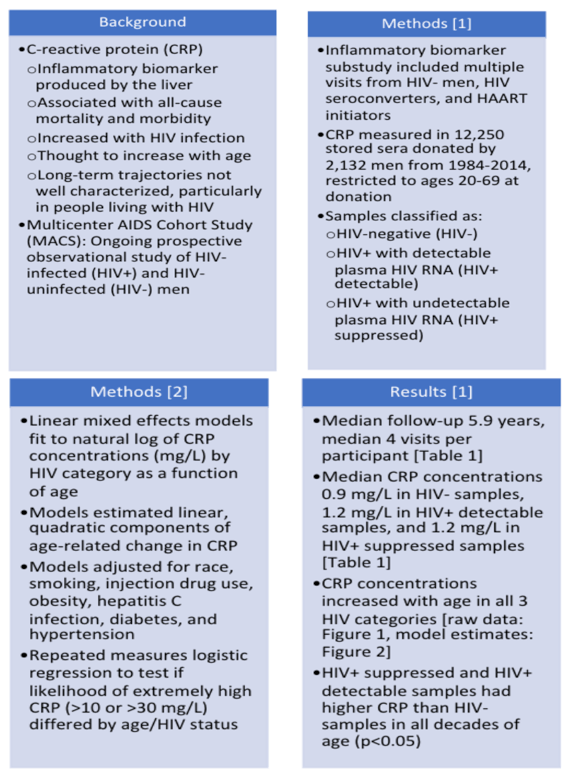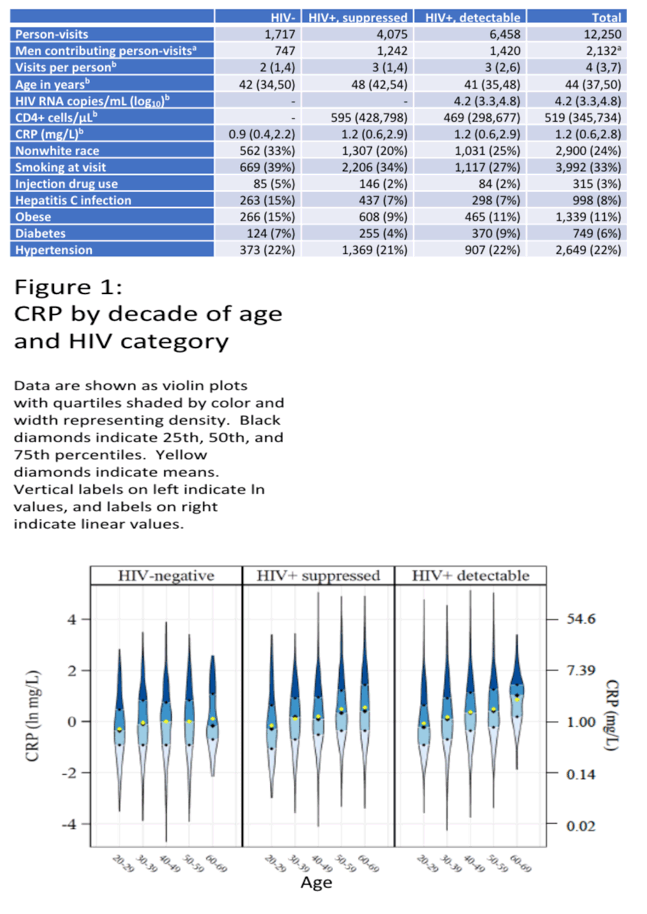 |
 |
 |
| |
Age-Related Trajectories of C-Reactive Protein Among Men With and Without HIV Infection in the Multicenter AIDS Cohort Study
|
| |
| |
Conclusions: We observed higher serum concentrations of CRP in men living with HIV, and steeper increases with age among samples from men with detectable HIV RNA, relative to HIV-negative samples. These results are consistent with postulated accelerated physical aging associated with HIV infection.
• CRP concentrations increased with age
• Relative to HIV- samples, HIV+ detectable samples had higher odds of having extremely high CRP values: >10 mg/L (OR: 1.74, 1.22 to 2.48) and >30 mg/L (OR: 2.84, 1.29 to 6.25).
• HIV+ detectable samples had higher odds of having extremely high CRP values
• relative to HIV- samples, CRP concentrations at age 45 years were 38% (95% CI: 26% to 50%) higher in HIV+ detectable samples and 26% (15% to 38%) higher in HIV+ suppressed samples. Linear growth as a function of age was more rapid in HIV+ detectable samples (8% higher per decade, 0.3% to 16%) relative to HIV- samples.

Intl. Aging & HIV Workshop 2020 Sept 29-Oct 2 virtual
Reported by Jules Levin
Wada N1, Breen E2, Post W3,4, Stosor V5, Macatangay B6, Margolick J3,4
1N/A, Brooklyn, United States, 2UCLA Department of Psychiatry and Biobehavioral Sciences, Los Angeles, United States, 3Johns Hopkins University School of Medicine, Baltimore, United States, 4Johns Hopkins Bloomberg School of Public Health, Baltimore, United States, 5Northwestern University Feinberg School of Medicine, Chicago, United States, 6University of Pittsburgh, Pittsburgh, United States
ABSTRACT
Background: C-reactive protein (CRP) is an inflammatory biomarker with prognostic value for all-cause mortality and for morbidities such as cardiovascular disease. CRP is thought to increase with age, though trajectories of CRP associated with aging have not been well characterized. HIV infection is known to increase CRP concentrations. We investigated trajectories of CRP in men from the Multicenter AIDS Cohort Study, and whether these trajectories differed by HIV infection and/or HIV viral load status.
Materials and Methods: We analyzed CRP measurements from 12,191 serum samples provided by 2,132 men who were aged 20-69 years at time of donation, and categorized samples by HIV status of the donor at the time of sample provision: HIV-negative (HIV-), HIV+ with undetectable RNA (<50 copies/mL, HIV+ suppressed), and HIV+ with detectable RNA (HIV+ detectable). To assess age-related trajectories of CRP, we fit multivariable linear mixed models to the natural log of CRP concentrations by age (adjusted for race, smoking status, injection drug use, obesity, active hepatitis C infection, diabetes, and hypertension), and we tested for differences in age-related changes in CRP concentrations by HIV status. We also fit logistic regression models adjusted for repeated measurements to test whether the likelihood of extremely high CRP measurements (>10 mg/L or >30 mg/L) differed by HIV and viral load status.
Results: CRP concentrations increased with age at a diminishing rate in all three sample groups. HIV+ suppressed and HIV+ detectable samples had higher concentrations of CRP than HIV- samples throughout the observed age range (p<0.05 from unadjusted linear mixed effects models), and these concentrations increased more rapidly with age in the HIV+ than in the HIV- samples. Results were similar between HIV+ suppressed and HIV+ detectable samples. From the adjusted model, relative to HIV- samples, CRP concentrations at age 45 years were 38% (95% CI: 26% to 50%) higher in HIV+ detectable samples and 26% (15% to 38%) higher in HIV+ suppressed samples. Linear growth as a function of age was more rapid in HIV+ detectable samples (8% higher per decade, 0.3% to 16%) relative to HIV- samples. Estimated average CRP concentrations peaked at 60 years of age in HIV- samples, at 67 years in HIV+ suppressed samples, and at 76 years for HIV+ detectable samples. Relative to HIV- samples, HIV+ detectable samples had higher odds of having extremely high CRP values: >10 mg/L (OR: 1.74, 1.22 to 2.48) and >30 mg/L (OR: 2.84, 1.29 to 6.25).
Conclusions: We observed higher serum concentrations of CRP in men living with HIV, and steeper increases with age among samples from men with detectable HIV RNA, relative to HIV-negative samples. These results are consistent with postulated accelerated physical aging associated with HIV infection.



|
| |
|
 |
 |
|
|